Your website should be making you money. But if you're like most Atlanta B2B leaders, you're not exactly sure how much it's contributing to your bottom line. You know it's important, you've invested in it, but measuring its actual return feels like trying to nail jello to a wall.
Here's the thing: calculating website ROI doesn't have to be complicated. Atlanta's most successful B2B firms use straightforward methods to track exactly how their websites pay for themselves—and then some. They know which metrics matter, which ones don't, and most importantly, they can prove their website investment makes financial sense.
This guide breaks down practical ways to calculate your B2B website return on investment. We'll skip the fluff and focus on methods that actually work for B2B companies in Atlanta's competitive market. Whether you're justifying a new website project or measuring your current site's performance, you'll find approaches that fit your business model and give you real numbers to work with.
Why Website ROI Matters for Atlanta B2B Companies
The Atlanta Business Context
Atlanta's B2B market moves fast. Your competitors aren't sitting still, and neither are your potential clients. When someone needs a vendor, partner, or service provider, they start with Google. They research quietly, comparing options before ever reaching out. By the time they contact you, they've already formed opinions based on what they found online.
The cost of having a weak website in Atlanta isn't just about looking outdated. It's about losing deals you never knew existed. Your competitors with stronger web presence capture those early-stage researchers while you're waiting for the phone to ring.
Beyond Vanity Metrics
Traffic numbers feel good to report, but they don't deposit checks. A thousand visitors mean nothing if none of them become customers. The same goes for social media followers, page views, and time on site. These metrics have their place, but they're not ROI indicators on their own.
What actually drives revenue for B2B websites?
- Lead quality
- Conversion rates
- Sales cycle acceleration
Successful Atlanta firms track:
- How many qualified prospects their websites generate
- How those prospects move through the sales funnel
- How website interactions influence deal closure
They care about metrics that connect directly to revenue, not numbers that just look impressive in reports.
The Real Cost of a Poor Website
A weak website costs you more than you think:
- Every prospect who can't find what they need bounces to a competitor
- Every sales rep who spends hours answering basic questions could be closing deals instead
- Every manual process that could be automated eats into your margins
Think about your sales team's daily routine. How much time do they spend sending the same product sheets, answering the same questions, or explaining the same differentiators? A strategic website handles these tasks automatically, freeing your team to focus on high-value activities. The opportunity cost of not having these efficiencies compounds daily.
An Example of Smart Design and Social Proof in Action
NCR Voyix is a standout example of an Atlanta-based company that uses its website as a competitive B2B marketing tool. The home page is strategically designed to guide visitors through its solutions in a clear, user-friendly way, making it easy for prospects to identify offerings relevant to their needs.
By incorporating impressive numbers and statistics—such as the scale of their customer base or transaction volumes—they build immediate credibility and leverage the power of social proof to influence decision-makers.
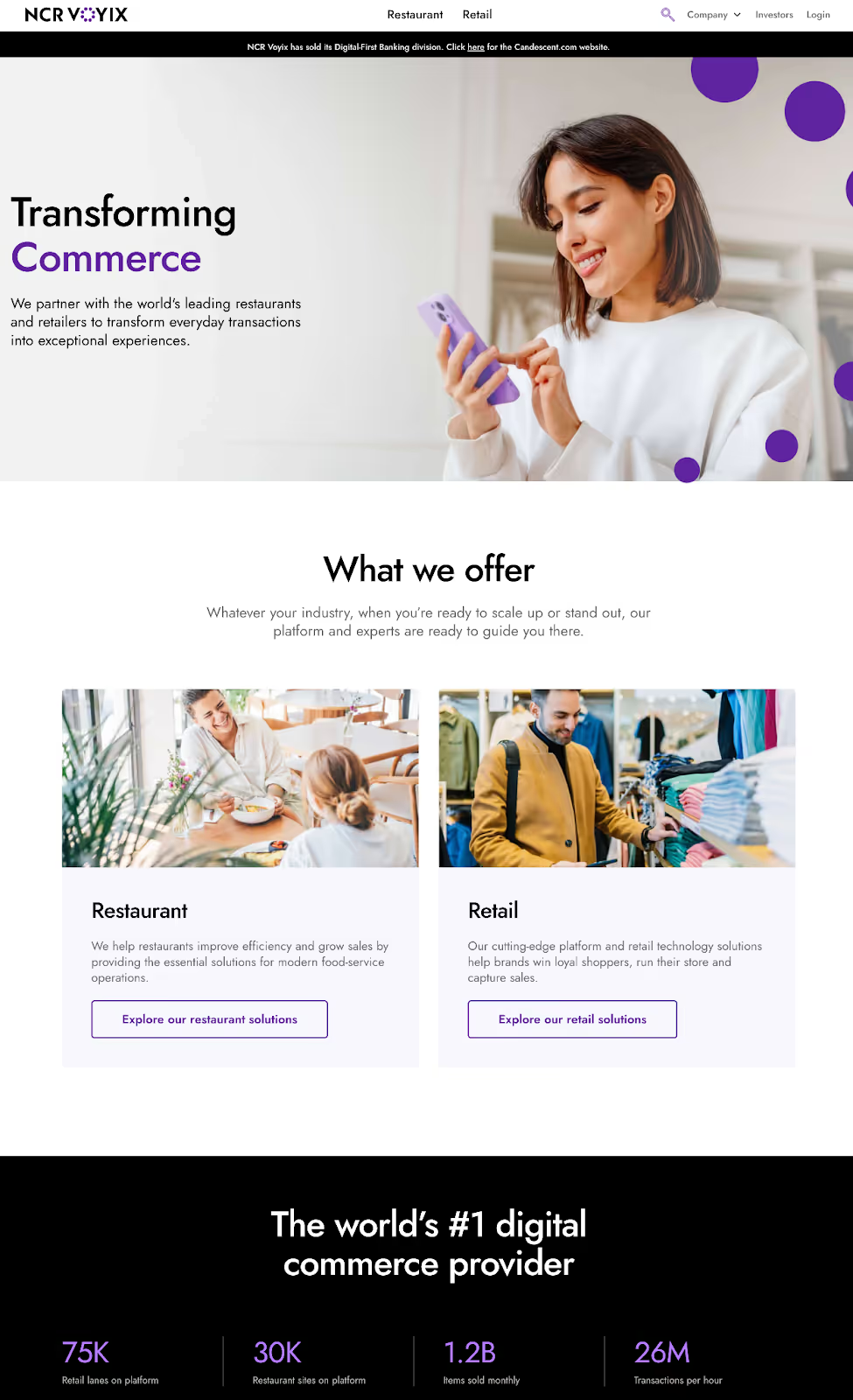
The site also prominently features logos of well-known brands they’ve worked with, reinforcing their authority and demonstrating real-world trust from industry leaders. It’s a strong example of how home page design can attract, reassure, and convert visitors in the competitive Atlanta B2B market.

Understanding the True Investment
Initial Website Costs
Website investments vary widely, but for B2B companies serious about results, expect to invest thoughtfully. The cheapest option rarely delivers the best ROI. A bargain-basement website might save money upfront but cost you deals for years. Quality websites that generate measurable returns require strategic planning, professional execution, and ongoing optimization.
The initial investment covers more than just B2B website design and development. It includes:
- Strategy work
- Content creation
- Technical setup
- Training
Each component contributes to the site's ability to generate returns. Cutting corners on any piece weakens the whole system.
Ongoing Investment Factors
Your website isn't a one-time expense. It requires ongoing investment to maintain its effectiveness. These ongoing costs include:
- Hosting
- Security updates
- Content creation
- Periodic improvements based on performance data
Smart companies budget for these from the start rather than being surprised later. You’ll also need to factor in:
- Content Creation: The development of valuable content deserves special attention. B2B buyers consume multiple pieces of content before making contact. They want case studies, detailed service descriptions, thought leadership articles, and resources that demonstrate expertise. Creating this content takes time and money, but it's essential for generating qualified leads.
- Marketing and Promotional Costs: Be sure to factor these into your ongoing investment as well. A beautiful website hidden from search engines won't generate ROI. You'll need to invest in SEO, possibly paid advertising, and definitely in promoting your content through various channels. These aren't optional extras—they're fundamental to achieving returns.
Time Investment Considerations
Money isn't your only investment. Your team's time has value too. During development, you'll spend hours in meetings, reviewing designs, and providing content. After launch, someone needs to respond to leads, update content, and monitor performance.
A professionally built B2B website typically takes 5–6 months, though projects can extend further if significant changes are introduced during the build. This timeline includes stages such as:
- Research and selection (1 week–1 month)
- Initial communication and goal setting (1–3 weeks)
- Design and build stages (1–2 months, or up to 3–4 months depending on revisions and changes)
- Final review and revision (1–2 weeks)
The learning curve for new systems affects the ROI timeline too. If your team needs weeks to understand the new CMS or lead management system, that's productive time lost. Factor this into your calculations when comparing website options. Sometimes a slightly higher investment in a more intuitive system pays for itself through reduced training time.
Opportunity Costs
While you're deliberating about your website, competitors are capturing your market share. Every month of delay means:
- Lost prospects
- Lost revenue
- Lost market position
These opportunity costs often exceed the actual website investment.
The compound effect makes delays even costlier. A strong website:
- Attracts links
- Builds search rankings
- Generates content authority over time
Starting later means your competitors get these compounding benefits while you're still planning. In competitive Atlanta markets, 6 months of delay could mean years of catching up.
Key Performance Indicators for B2B Website ROI
Essential Metrics to Track
B2B websites need different metrics than e-commerce or consumer sites, including:
- Conversion Rates: Conversion rates for B2B typically range from 2–5%, much lower than consumer sites (but with much higher transaction values). A 2% conversion rate sounds low until you realize each conversion could represent a 6-figure contract.
- Lead Quality Scores: These scores matter more than lead quantity. 10 highly qualified prospects beat 100 tire-kickers every time. Track not just how many leads you generate, but how many match your ideal customer profile, have budget authority, and show genuine buying intent. Your sales team can help define what makes a lead truly qualified for your business.
- Cost Per Acquisition: This cost tells you how much you're spending to land each customer through your website. This includes your website investment spread out over time, plus ongoing marketing costs, divided by customers acquired. Compare this to your customer lifetime value to see if your investment math works.
Atlanta B2B Benchmarks
Atlanta B2B firms often outperform national averages in certain metrics. Our city's strong business network means referral traffic and direct traffic tend to be higher. Local SEO also plays a bigger role here than in less concentrated markets. Understanding these regional differences helps set realistic expectations.
Industry variations matter too:
- Professional services firms might see higher conversion rates but longer sales cycles
- Manufacturing companies might have fewer leads but much higher average deal values
- Technology companies might see more organic search traffic due to their content marketing efforts
Know your industry's norms before judging your performance.
Leading vs. Lagging Indicators
Some metrics predict future success, while others only confirm past performance.
Leading indicators that suggest future revenue potential include:
- Organic traffic growth
- Email subscribers
- Content engagement
Lagging indicators confirm what already happened, such as:
- Closed deals
- Revenue generated
Watch leading indicators for early warning signs. If organic traffic starts declining, you'll see revenue impacts months later. If email engagement drops, lead quality will suffer down the line. These early signals give you time to adjust before revenue takes a hit.
The Revenue Side: What B2B Websites Actually Generate
Direct Revenue Indicators
- Lead Generation Improvement: This is the most obvious revenue indicator. A well-designed B2B website can double or triple lead flow within the first year. But volume alone isn't the goal. Quality matters more. Your website should attract prospects who actually fit your ideal customer profile, have real needs, and possess buying authority.
- Conversion Rate Increases: Conversion rate increases compound these gains. If you double your traffic and improve conversion from 2–3%, you haven't just improved by 50%—you've tripled your lead generation. Small conversion improvements create massive revenue impacts when combined with traffic growth.
- Average Deal Size: Deal size often increases with a professional website. Prospects who research thoroughly online arrive better educated about your value proposition. They understand your differentiators and pricing rationale. This preparation leads to less price resistance and higher contract values.
- Sales Velocity: Sales velocity is how quickly deals close, and it accelerates with good websites. Prospects who've consumed your content, reviewed case studies, and understood your process move through the pipeline faster. They've essentially pre-sold themselves, making your sales team's job easier and shorter.
SalesLoft’s Home Page: Featured Metrics That Speak for Themselves
AI revenue orchestration platform SalesLoft features a number of trust-building performance metrics on its home page, alongside glowing testimonials from real customers. The site touts impressive expectations like “See 4.4x faster ROI with SalesLoft,” immediately giving prospects concrete proof of its impact. Throughout the site, SalesLoft leverages additional metrics (such as a 12% higher closed/won rate and 3.3x ROI over three years) to demonstrate measurable success.
Customer testimonials are prominently displayed, highlighting real-world experiences from recognizable companies and adding credibility. The site links directly to in-depth case studies, giving prospects a chance to explore the stories behind these results. Awards and recognitions are also featured to reinforce SalesLoft’s authority in the revenue orchestration space.
By combining social proof, quantifiable outcomes, and easy access to deeper resources, SalesLoft creates a compelling narrative that builds trust and encourages prospective customers to take action.
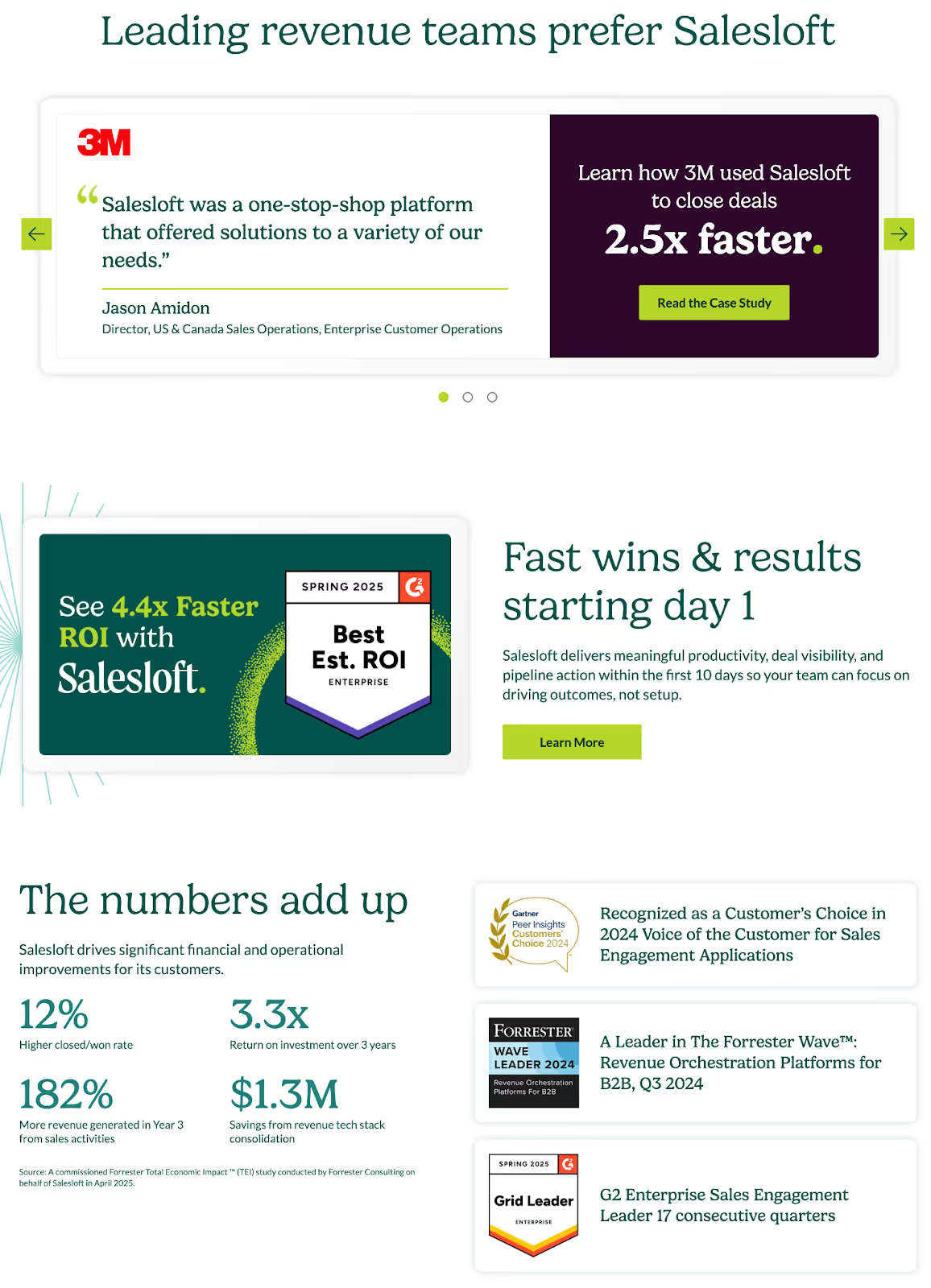
Sales Efficiency Gains
Your sales team becomes dramatically more efficient with proper website support. Instead of explaining basics repeatedly, they can focus on relationship building and complex problem-solving. Prospects arrive pre-educated, asking sophisticated questions rather than requesting basic information.
Proper website support includes:
- Automated Initial Touchpoints: Automated touchpoints are how your site handles routine inquiries without human intervention. Contact forms, chatbots, and automated email responses can qualify prospects and provide initial information instantly. Your sales team only engages with qualified prospects who need human attention.
- Better Sales Materials Access: This means reps spend less time searching for documents and more time selling. A well-organized website becomes a sales tool itself, with case studies, testimonials, and proof points readily available during calls. Proposals practically write themselves when all supporting materials are centralized and current.
Cost Reduction Benefits
Beyond generating revenue, websites reduce costs across your organization.
- Automated Quote Requests: Automated quote engines eliminate hours of back-and-forth emails. Prospects submit requirements through detailed forms, receiving instant estimates for standard services. Your team only handles complex, non-standard requests that truly need human expertise.
- Self-Service Resources: Customer service calls decrease when FAQs and support resources are easily found online. Documentation, video tutorials, and knowledge bases let customers find answers independently, improving customer satisfaction while significantly reducing support burden and costs. Each call avoided saves money and frees your team for higher-value work.
- Print Materials: These become largely unnecessary with a comprehensive website. Instead of printing expensive brochures that quickly become outdated, you maintain current information online. The savings in design, printing, and shipping costs add up quickly.
- Travel Expenses for Sales Teams: Travel expenses decrease when prospects can experience your capabilities online. Virtual tours, detailed case studies, and video demonstrations replace many in-person visits. Your team travels only for high-value opportunities that truly require face-to-face interaction.
An Example of Self-Service Made Simple
AI and data solutions platform OneTrust makes it easy for customers to find answers and get the most out of its products through a robust “Resources” section in its navigation menu. This hub includes self-service guides, training and events, and dedicated support resources, helping users quickly solve problems on their own.
By providing these tools upfront, OneTrust not only improves customer satisfaction but also reduces the number of support calls and the associated costs—making life easier for both customers and the company.
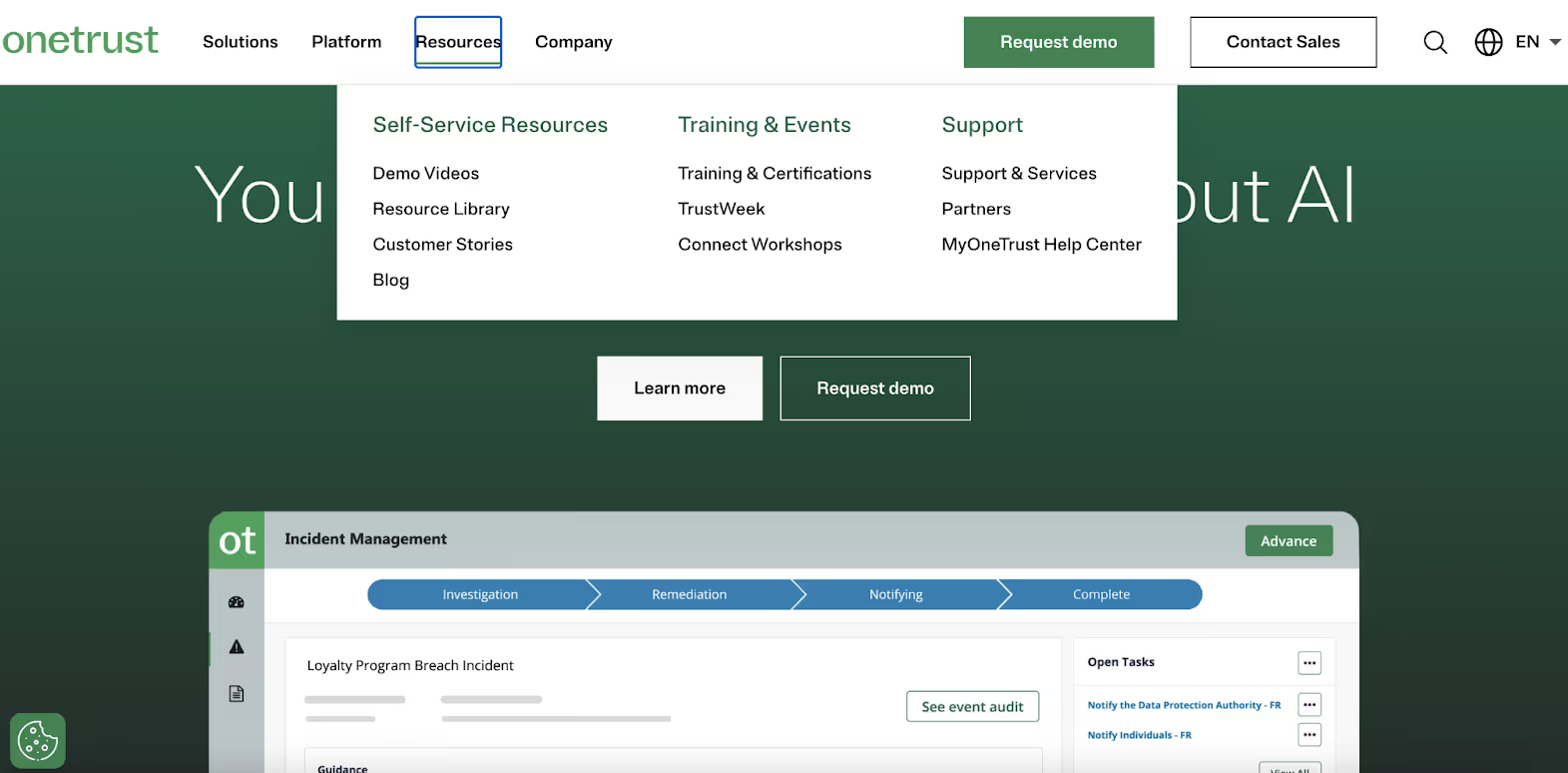
Once visitors dig into OneTrust’s “All Resources” section, they’ll find that it’s been thoughtfully designed for a smooth user experience. Visitors can filter content by type, topic, or regulation so they can find exactly what they need without wading through irrelevant information. This level of organization makes it easy for users to access relevant guidance, stay up to date on compliance requirements, and feel confident using OneTrust’s solutions effectively.
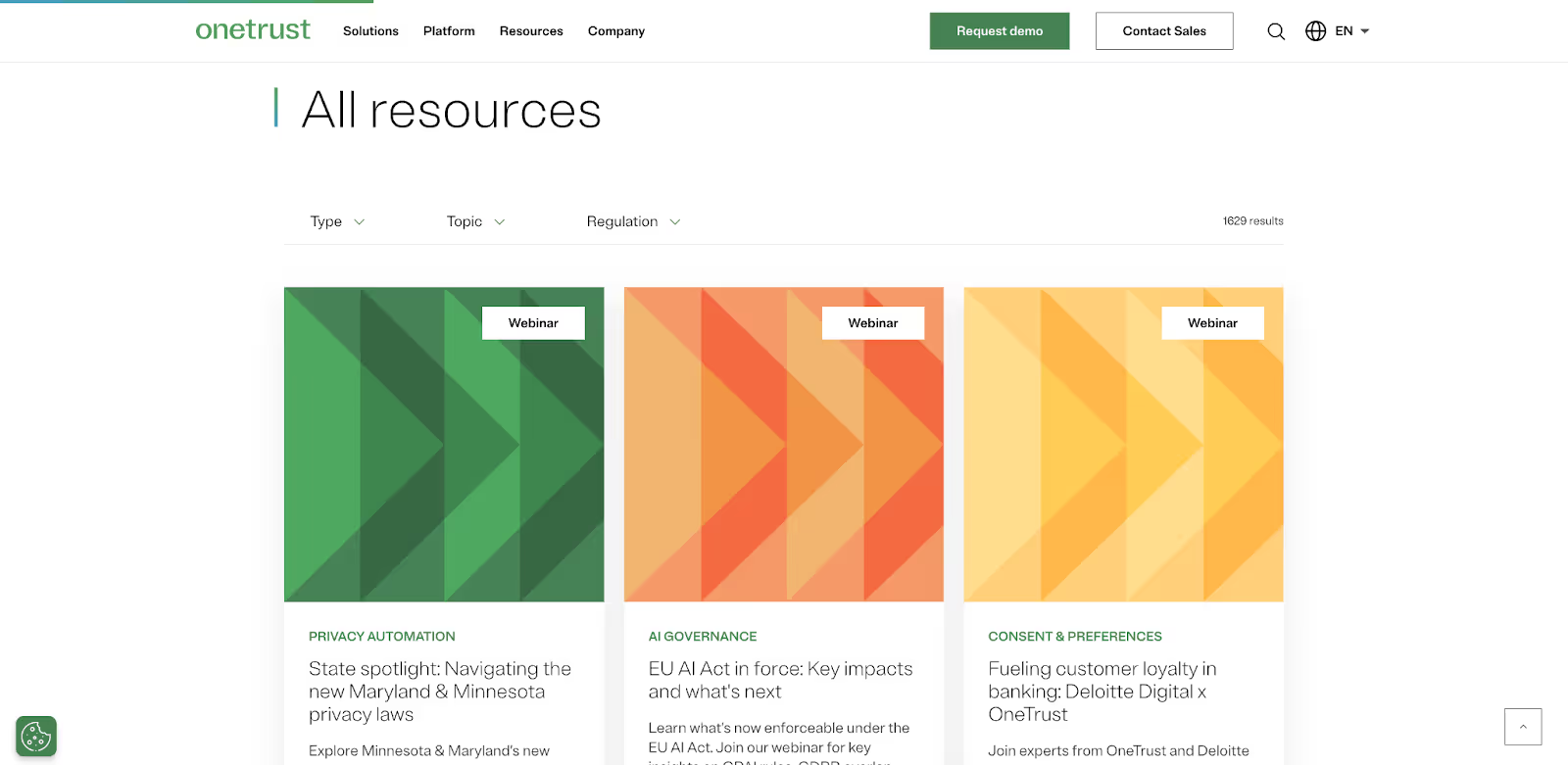
Brand Value Enhancement
A professional website enhances brand value in ways that directly impact revenue, such as:
- Enhanced Market Credibility: Market credibility increases when prospects see a polished, professional web presence. They assume companies with excellent websites deliver excellent service—and they're usually right.
- Justified Premium Pricing: Premium pricing becomes easier to justify with a website that demonstrates value. When prospects can see detailed case studies, understand your process, and appreciate your expertise, they're willing to pay for quality. Your website makes the value-price equation clear.
- New Partnership Opportunities: Partnership opportunities emerge when other businesses see you as a peer rather than a vendor. A strong web presence attracts strategic partners, referral sources, and collaboration opportunities that wouldn't exist otherwise.
Technical Performance and Its ROI Impact
Load Time Economics
Speed equals money in the digital world. Here’s how:
- Faster Load Times Boost Conversion: Every second of delay reduces conversions by approximately 7%. For B2B sites with longer, more considered buying cycles, slow load times erode trust and credibility. Prospects assume slow websites indicate slow service delivery.
- Mobile Speed Improves Leads: Mobile performance particularly matters for B2B buyers who research during commutes, between meetings, or while traveling. A site that loads instantly on mobile captures these micro-moments of research. A slow mobile experience loses these opportunities forever.
- Core Web Vitals Impact SEO: Core Web Vitals—Google's speed and user experience metrics—directly impact search visibility. Better technical performance means higher rankings, more organic traffic, and ultimately more leads. The compound effect of improved rankings creates lasting ROI advantages.
Bounce Rate and User Experience
Technical problems drive visitors away before they can become prospects. Broken forms, confusing navigation, and poor mobile experiences cause bounces that represent lost revenue. Each bounced visitor is a potential customer who chose a competitor instead.
Poor site performance creates hidden costs beyond lost prospects. Your paid advertising becomes less effective when technical issues cause bounces. You're essentially paying to send traffic to competitors. Marketing ROI suffers when the website can't convert the traffic you're buying.
SEO Technical Foundation
Site speed affects search rankings directly. Google has confirmed that page speed is a ranking factor, particularly for mobile searches. Faster sites rank higher, get more organic traffic, and generate more leads without additional marketing spend.
Technical SEO creates compound benefits over time. Unlike paid advertising that stops when budgets end, technical improvements continue delivering value. A faster, better-structured site accumulates authority, builds rankings, and generates increasing organic traffic month after month.
In today’s competitive market, technical performance isn’t just an IT issue—it’s a sales and marketing issue. A slow, unstable site can discourage prospects before they ever learn about your solutions, costing you valuable leads and conversions.
You can run a PageSpeed Insights test of your own website pages to determine where your site is succeeding and where it could use some work. Below each metric, you’ll find expandable insights and diagnostics that you can use to improve your website and your conversions.
Practical ROI Calculation Methods
The Simple ROI Formula
The basic ROI calculation seems straightforward:
- Take your gain from investment
- Subtract the cost of investment
- Divide by the cost of investment
- Then multiply by one hundred
For websites, this means you:
- Measure revenue generated
- Subtract website costs
- Divide by website costs
Here's how this looks for a typical Atlanta B2B firm. You invest $40,000 in a new website. Over 2 years, that website generates 20 new customers worth $300,000 total. Subtract the $40,000 investment from the $300,000 gain, divide by $40,000, and multiply by 100. Your ROI is 650%.
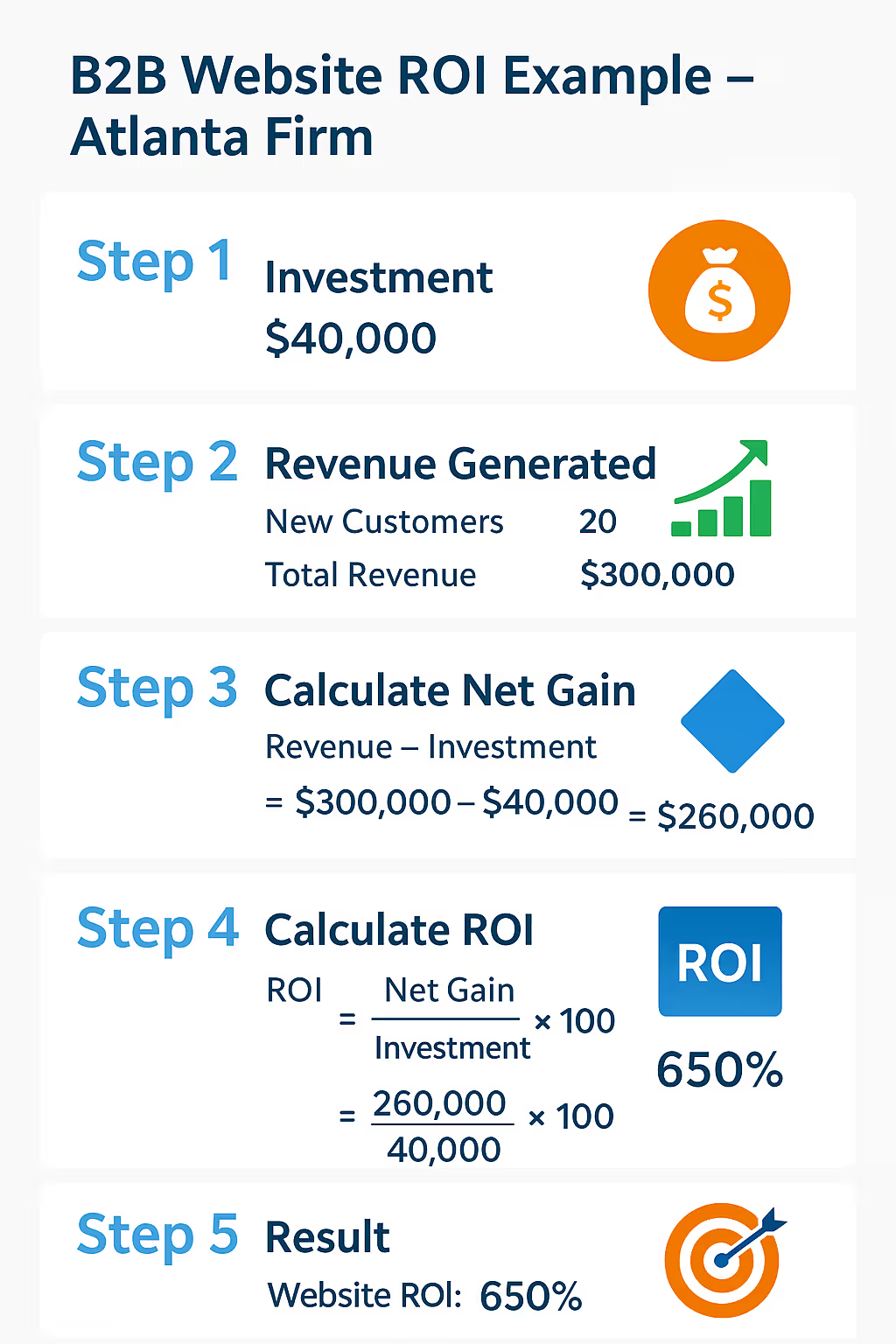
This method works best for businesses with clear attribution between website leads and closed deals. If you can track exactly which customers came through your website and what they spent, this formula gives you a clean ROI number. The challenge comes when attribution gets murky, which happens often in complex B2B sales.
Lead Generation ROI Model
A more nuanced approach focuses on lead generation metrics. Start by establishing your baseline: how many leads do you generate monthly without the new website? Then project realistic improvements based on industry benchmarks and your specific improvements.
Calculate your current lead value by dividing total sales by total leads. If you close 1 in 10 leads and your average deal is $50,000, each lead is worth $5,000. If your new website doubles lead generation from 10 to 20 monthly, that's an additional $50,000 in monthly value.
Factor in conversion rate improvements too. If your new website also improves conversion from 10–15%, those 20 leads now generate 3 closes instead of 2. That's an extra $50,000 monthly, or $600,000 annually. Against a $40,000 investment, the math becomes compelling quickly.
This model accounts for the reality that not all leads close and that website improvements affect both quantity and quality of leads. It's particularly useful for businesses with longer sales cycles where direct attribution is difficult.
Customer Lifetime Value Method
Sophisticated B2B firms think beyond initial sales to customer lifetime value. A website that attracts higher-quality customers who stay longer and buy more creates compound ROI that simple calculations miss. In fact, improving customer retention by just 5% can increase profits by 25–95% in the B2B space.
Start by calculating your current customer lifetime value. Include:
- Initial purchase
- Repeat business
- Referral value
Then assess how your website improvements might affect each component. For example:
- Better onboarding content might improve retention
- Clearer value communication might increase purchase frequency
- Stronger case studies might generate more referrals
If your website improvements increase average customer lifetime value from $100,000 to $120,000, every customer becomes 20% more valuable. Applied across your entire customer base, this creates massive long-term ROI that dwarfs the initial investment.
Time Savings Calculator
Quantifying efficiency gains requires putting dollar values on time saved. Start by documenting current time investments in routine tasks. How many hours weekly does your team spend:
- Answering basic questions?
- Sending standard documents?
- Qualifying leads?
Calculate the dollar value of these hours using fully loaded employee costs, not just salaries. Include:
- Benefits
- Overhead
- Opportunity costs
If a sales rep costing $150/hr spends 10 hours weekly on tasks your website could automate, that's $78,000 annually.
Automation impact extends beyond obvious tasks:
- Consider reduced meeting time when prospects arrive better informed
- Account for faster proposal development when materials are centralized
- Include decreased training time when processes are documented online
These efficiency gains often justify website investment alone, before considering revenue generation.
Tools for Measuring B2B Website ROI
Analytics Platforms
- Google Analytics 4: GA4 provides the foundation for ROI tracking. Set up conversion goals for form submissions, resource downloads, and key page visits. Configure e-commerce tracking even if you don't sell online—use it to assign values to different conversion types. This lets you see dollar values, not just conversion counts.
- Custom Dashboards: Dashboards make ROI monitoring efficient. Build dashboards that show your key metrics at a glance: qualified leads generated, conversion rates by source, and goal values over time. Schedule automated reports so stakeholders see progress without asking.
- Attribution Modeling: Attribution becomes crucial for B2B with longer sales cycles. Use data-driven attribution to understand how different touchpoints contribute to conversions. This reveals which content and channels drive the most valuable outcomes, informing future investment decisions.
CRM Integration
Connecting your website analytics to your CRM creates full-funnel visibility. HubSpot, Salesforce, and similar platforms can track prospects from first website visit through closed deal. This closed-loop reporting definitively proves website ROI by connecting online behavior to revenue.
Set up proper tracking codes and UTM parameters to maintain attribution accuracy. Every campaign, email, and social post should have tracking that follows prospects into your CRM. This granular tracking reveals which specific website investments generate the highest returns.
Specialized ROI Tools
- Heat Mapping Tools: Tools like Hotjar or Crazy Egg show how visitors actually use your site. These insights identify conversion barriers that analytics alone might miss. Fixing these issues based on real user behavior often produces immediate ROI improvements.
- Call Tracking Platforms: These types of platforms prove phone lead attribution. Services like CallRail assign unique numbers to different traffic sources, showing which website visitors call and what happens to those leads. For B2B companies where phone contact remains important, this attribution is essential.
- Form Analytics Tools: Tools like Formstack or Typeform provide detailed conversion insights. See where prospects abandon forms, which fields cause friction, and how form changes affect completion rates. Small improvements in form conversion can dramatically impact lead generation ROI.
Maximizing Your Website ROI
Pre-Launch Optimization
- Set Measurable Goals: Clear goal setting determines everything else. Define specific, measurable objectives for your website before design begins. Instead of vague goals like "generate more leads," set targets like "increase qualified leads by 40% within 6 months." These specific goals guide every decision and provide clear success metrics.
- Conduct Audience Research: Audience research prevents expensive mistakes. Interview current customers about their buying process. Survey lost prospects about their decision criteria. Study competitor websites to identify gaps and opportunities. This research ensures your website addresses real needs, not assumed ones.
- Plan Content Strategically: Content strategy planning multiplies ROI potential. Map content to each stage of the buyer journey. Plan resources that sales teams need most. Identify topics that demonstrate expertise and build trust. Strong content strategy turns websites from digital brochures into revenue engines.
How North Highland Offers Conversion Paths for Every Visitor
North Highland, a global consulting firm that helps organizations solve complex business challenges, uses its homepage to guide visitors toward clear next steps. Right beneath the hero section, two prominent CTA buttons—“Let’s Get to Work” and “See How”—invite users to either dive straight into solutions or explore the firm’s approach in more detail.

For visitors who aren’t ready to talk yet, the “What are you looking to tackle today?” question offers multiple topic-based pathways, allowing users to engage with content that matches their interests without pressure. This thoughtful mix of direct and exploratory options ensures there’s a conversion path for every stage of the buyer’s journey, ultimately boosting the likelihood that casual visitors become qualified leads.
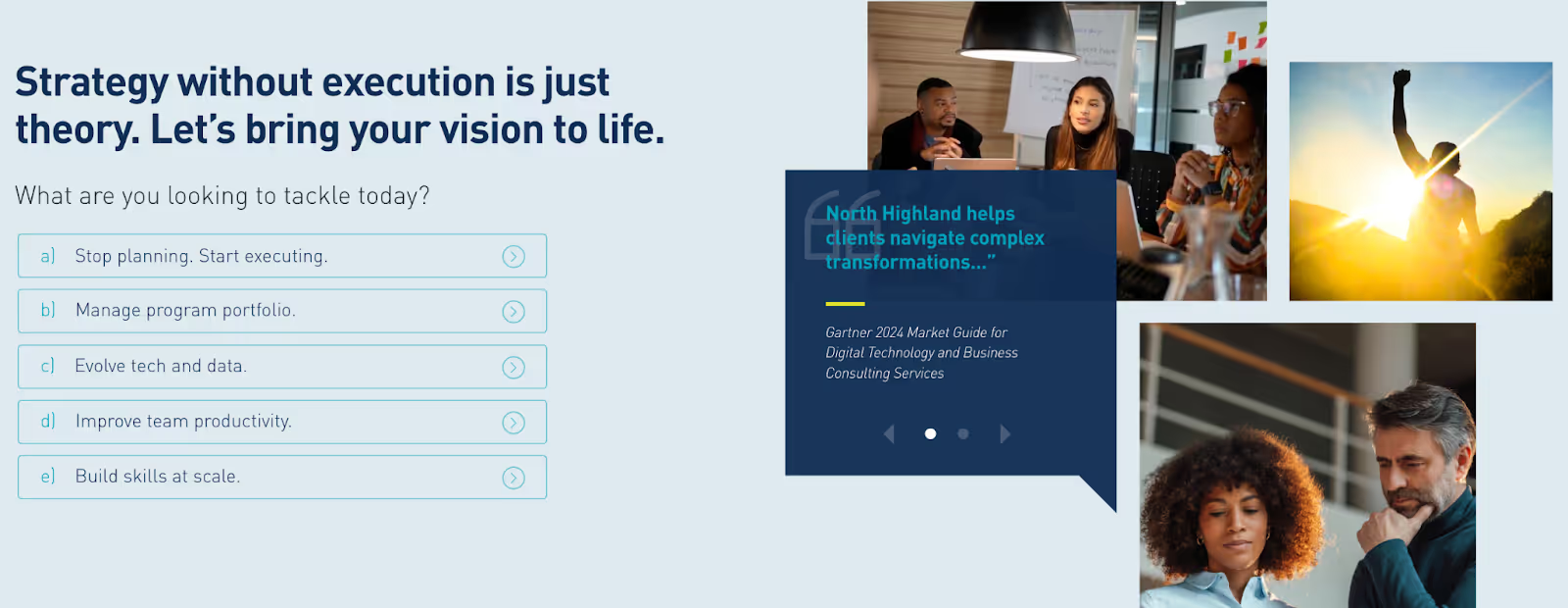
Post-Launch Strategies
- Implement Regular Reviews to Monitor Performance: Continuous improvement based on data separates high-ROI websites from static ones. Monthly performance reviews identify what's working and what isn't. Quarterly optimization sprints implement improvements based on these insights. Annual strategic reviews ensure the website evolves with your business.
- Test Conversion Elements: A/B testing reveals what actually drives conversions versus what you think should work. Test headlines, button colors, form lengths, and page layouts. Small improvements compound over time. A 2% conversion rate becoming 3% represents a 50% improvement in lead generation.
- Publish Valuable Content Consistently: Content marketing integration amplifies website ROI. Regular blog posts, case studies, and resources attract organic traffic and nurture prospects. Each piece of quality content becomes a permanent asset generating returns for years. The compound effect of consistent content creation often exceeds the returns from any other website investment.
Leveraging Atlanta Resources
- Immerse Yourself in Local Networks: Atlanta's business community offers unique amplification opportunities. Local business associations, chambers of commerce, industry groups, and networking groups provide platforms to showcase your expertise and drive traffic. Speaking at local events and participating in Atlanta business initiatives builds authority and generates quality backlinks.
- Improve Regional Visibility With Strategic Content: Atlanta-specific SEO opportunities abound for B2B firms. Target neighborhood business districts, industry clusters, and local partnership opportunities. Create content about Atlanta business trends, local success stories, and regional market insights. This local relevance improves search visibility and resonates with regional prospects.
- Collaborate With Local Businesses: Partnership possibilities multiply website ROI. Cross-promotion with complementary Atlanta businesses expands reach without additional investment. Guest posting on local business blogs builds authority and generates referral traffic. Strategic partnerships turn your website into a hub for your business ecosystem.
Common ROI Killers to Avoid
Design Without Strategy
Here’s what can go wrong if your design lacks a guiding strategy:
- Prioritizing aesthetics over functionality kills ROI. Beautiful websites that don't convert are expensive decorations. Every design decision should support business objectives, not designer preferences. If you can't explain how a design element helps achieve goals, it probably doesn't belong.
- Missing or weak calls-to-action waste traffic. Visitors need clear next steps on every page. Don't assume they'll figure out how to contact you or what to do next. Strong calls-to-action guide visitors toward conversion, turning traffic into leads.
- Poor user experience frustrates prospects and sends them to competitors. Confusing navigation, unclear messaging, and difficult-to-find information all reduce conversions. Your website should make it effortless for prospects to understand your value and take action.
Technical Performance Issues
Watch out for these common website pitfalls that undermine ROI:
- Slow load times kill conversions before content even appears. Prospects won't wait for slow sites when competitors load instantly. Every second of delay reduces your ROI potential. Technical performance isn't optional—it's fundamental to generating returns.
- Poor mobile experiences eliminate half your potential ROI. B2B buyers research on phones during commutes, between meetings, and while traveling. If your site doesn't work flawlessly on mobile, you're losing these micro-moments of opportunity to competitors who do mobile right.
- Broken functionality destroys trust instantly. Forms that don't submit, links that lead nowhere, and features that don't work tell prospects you're unreliable. They assume your service delivery matches your website quality. One broken form could cost you multiple deals.
Neglecting Post-Launch
The "set it and forget it" approach guarantees declining ROI over time. Websites need constant attention to maintain effectiveness. Content gets stale, technology evolves, and competitor sites improve. Standing still means falling behind.
Fresh content keeps prospects coming back and search engines ranking you higher. Regular updates signal that your business is active and current. Abandoned websites suggest abandoned businesses. Prospects choose vendors who demonstrate ongoing vitality and relevance.
Misaligned Expectations
Unrealistic timelines lead to premature ROI judgments. B2B websites typically take 6–12 months to show significant returns. Expecting immediate results leads to abandoning strategies before they can work. Patience combined with consistent execution produces the best ROI.
Understanding the growth curve prevents panic and poor decisions. Initial months focus on foundation building: improving rankings, generating initial traffic, and refining conversion paths. Months three through six show acceleration as these foundations pay off. True ROI becomes clear after a full year of data.
When to Expect Payback
Typical Timeline for Atlanta B2B
The First 90 Days
The first 3 months establish foundations and baselines. You'll see initial traffic improvements and early leads, but don't expect dramatic ROI yet. This period focuses on:
- Technical optimization
- Initial content publication
- Establishing measurement systems
Early metrics provide baselines for measuring future improvement.
Months 3–6
Months 3–6 show momentum building:
- Organic traffic grows as search rankings improve
- Lead quality increases as messaging refinement takes effect
- Sales teams report easier conversations with better-prepared prospects
- ROI starts becoming visible but isn't yet compelling
Months 6–12
Months 6–12 deliver significant results:
- Compound effects of content marketing, SEO improvements, and conversion optimization create accelerating returns
- Lead generation might double or triple from baseline
- Sales cycles shorten as website resources support the sales process
- ROI calculations start showing strong positive returns
Years 2+
Year 2 and beyond produce compound growth:
- Established authority generates increasing organic traffic
- Content library provides ongoing value without additional investment
- Word-of-mouth referrals increase as successful customers share experiences
- ROI multiples become compelling, often reaching five to ten times initial investment
Factors That Accelerate ROI
These key elements typically drive quicker returns:
- Existing Market Presence: An already established reputation provides a head start. Atlanta businesses with recognition and relationships see faster website ROI than unknown startups. Your reputation transfers to your digital presence, accelerating trust building and conversion.
- Marketing Investment Level: Your marketing investment directly affects your ROI timeline. Businesses investing in SEO, content marketing, and paid promotion see faster returns than those relying on organic growth alone. Think of marketing investment as ROI acceleration fuel—the more you add, the faster you achieve payback.
- Sales Team Alignment and Training: Sales team readiness multiplies website effectiveness. When sales teams understand and use website resources, conversion rates improve dramatically. Training teams to leverage website tools, content, and analytics ensures maximum ROI from your digital investment.
Early Warning Signs of Success
Leading indicators like these suggest future ROI before revenue materializes:
- Increasing organic traffic
- Growing email subscribers
- Improving engagement metrics
These early signals indicate whether your website investment is on track.
Knowing when to double down versus when to pivot requires watching the right metrics.
- If quality traffic grows but conversions lag: Focus on conversion optimization
- If conversions are strong but traffic is weak: Invest in promotion
Let data guide your optimization decisions.
Red flags requiring course correction include:
- Declining traffic
- Increasing bounce rates
- Falling conversion rates
These indicators suggest problems that will worsen without intervention. Address issues quickly before they compound and destroy ROI potential.
Turning Your Website into a Revenue Engine
Calculating ROI on your B2B website design doesn't require an MBA or complex spreadsheets. The methods we've covered—from simple ROI formulas to sophisticated lifetime value calculations—give you practical ways to measure your website's financial impact. Choose the approach that fits your business model and data availability.
The key is measurement and optimization. Track the metrics that matter for your business, whether that's lead generation, sales cycle acceleration, or cost reduction. Use tools like Google Analytics and your CRM to maintain visibility into performance. Most importantly, act on what the data tells you.
Atlanta's competitive B2B landscape demands a strong digital presence. Your website isn't just a digital brochure—it's a revenue engine that should pay for itself many times over. The businesses winning in our market understand this and invest accordingly.
Start by choosing metrics that align with your business goals. Set up proper tracking systems. Establish baselines for current performance. Then systematically improve based on data, not assumptions. This disciplined approach virtually guarantees positive ROI from your website investment.
Ready to calculate your website's ROI potential? Start with an honest assessment of your current digital performance. Identify the gaps between where you are and where you need to be. Then take action—because every month of delay is money left on the table while competitors capture your market share.

